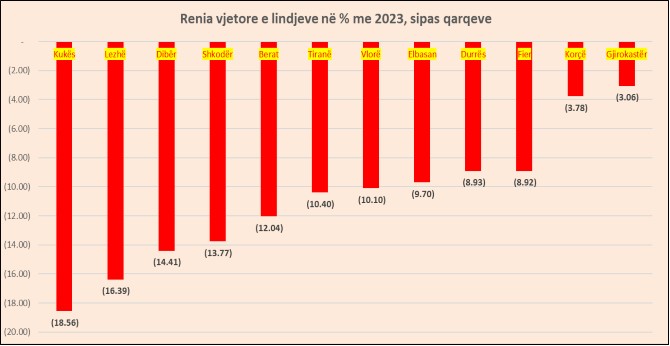Albania is facing a rapid decline in births, especially in the years following the pandemic, but in the northern regions, the phenomenon is intensifying even more.
While births at the national level fell by 10% in 2023 compared to 2022, in the Kukës County, the decline was even steeper at 18.5%.
In the Northern Region, the poorest in the country last year, only 667 babies were born compared to 819 in 2022. In the past decade, Kukës is the only county that has experienced an economic downturn, contrary to the national trend according to official data from INSTAT.
Kukës is suffering the consequences of both internal and external population migration. Since 2015, a massive channel of emigration to the United Kingdom has significantly worsened demographic indicators.
After Kukës, the largest decline in births in percentage terms was in Lezha with about 16.3% in 2023. In this county, 1,010 babies were born in 2023 compared to 1,208 the previous year, followed by Dibra where births decreased by 14.4% and Shkodra by 13.7%. Conversely, the southern counties experienced milder declines. For example, the lowest decline in births was in Gjirokastra County with 3%, and less in Korça with 3.7%, and Durrës, Elbasan, and Fier with around 9% each.
The capital city is also facing a decline in births, with a decreasing population year by year. Last year, 8,144 babies were born in Tirana, with an annual decline of 10.4%.
From 2013 to 2023, births at the national level decreased by 37%, with the highest rates for the 10-year period seen in Berat and Kukës at 52% and 50%, respectively.
INSTAT's official data indicates that nationwide, 22,210 babies were born last year, marking a 10% annual decline or 2,478 fewer babies than in 2022. This was the sharpest decline in the last 30 years since 1993 and has even exceeded the most pessimistic projections for the country's population trend until 2060 developed by INSTAT.
INSTAT data shows that during 2022, the fertility rate dropped to 1.21 children per woman of childbearing age, down from 1.32 in 2021. This is the sharpest decline since 2015. This means that out of 100 women of childbearing age, only 121 children were born, compared to 132 born in 2021.
Since 2001, the fertility rate has halved, dropping from a level of 2.31 children per woman to 1.21 children.Compared to Eurostat data from 2021, Albania is seen to have the lowest birth rates in Europe, surpassed only by Spain (1.19) and Malta (1.13).

0 comments